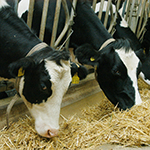Plant protection product residues in feed

Agricultural crops are fed to animals either in part (e.g. cereal straw) or in full (e.g. fodder beet). If these plants were previously treated using plant protection products, then the feed may contain residues of these products.
The residues in feed should be so low that they impair neither the health nor the yield of the animals, nor should they result in residue levels in food of animal origin that might pose a risk to consumers.
Feeding studies to determine plant protection product residues
Before a plant protection product is approved, BfR examines whether and in what concentration residues might occur in feed following use of the plant protection product, whether these might enter foods like milk, offal, fat, meat, eggs, fish or honey, and whether this can result in a health risk to consumers. The concentration of the residue in feed is determined based on studies in which the plant protection products were used under real-life conditions. In addition, metabolism and feeding studies on farm animals serve as a basis for determining whether and in what concentration residues occur in animal products.
Maximum residue levels are also set for food of animal origin. These levels must not pose either an acute or a chronic risk to consumers.
In the future, maximum residue levels specifically for feed will also be defined in line with Regulation (EC) No. 396/2005. Annex I of the regulation stipulates for which products maximum levels are to be defined and will be extended to cover feed, in addition to other commodities.
